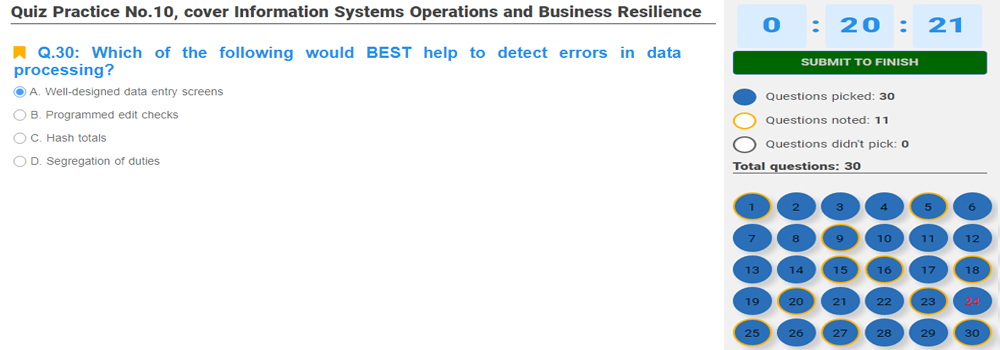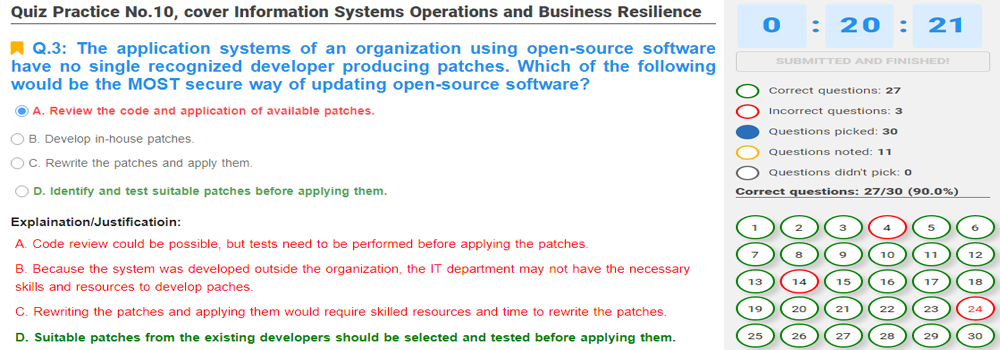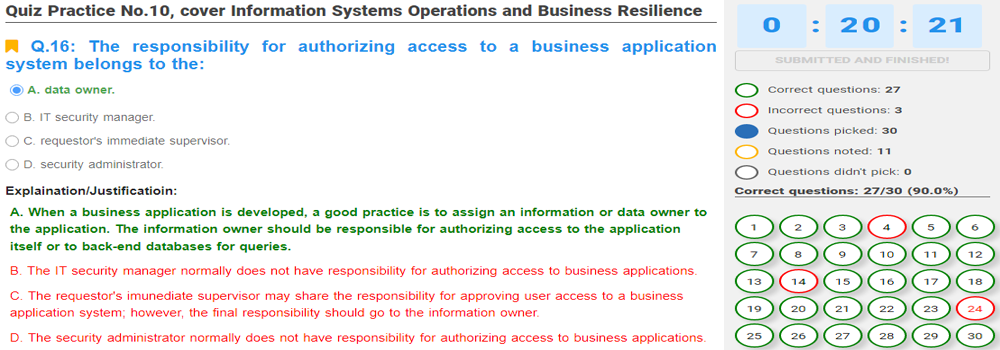[1Z0-082 DUMP UPDATED JULY, 2024] Oracle Database 19C Administration 1 Cert code: 1Z0-082, Questions of the exam: 72, Minutes of the exam: 120, Correct to pass: 60%.
[1Z0-082 DUMP UPDATED JUNE, 2024] Oracle Database 19C Administration 1 Cert code: 1Z0-082, Questions of the exam: 72, Minutes of the exam: 120, Correct to pass: 60%.
[1Z0-082 DUMP UPDATED APRIL, 2024] Oracle Database 19C Administration 1 Cert code: 1Z0-082, Questions of the exam: 72, Minutes of the exam: 120, Correct to pass: 60%.
[1Z0-082 DUMP UPDATED MARCH, 2024] Oracle Database 19C Administration 1 Cert code: 1Z0-082, Questions of the exam: 72, Minutes of the exam: 120, Correct to pass: 60%.
[1Z0-082 DUMP UPDATED JANUARY, 2024] Oracle Database 19C Administration 1 Cert code: 1Z0-082, Questions of the exam: 72, Minutes of the exam: 120, Correct to pass: 60%.
SOME NOTES ABOUT ORACLE DATABASE 19C ADMINISTRATION 1:
Oracle Database 19C Administration 1 [1Z0-082] is an important and mandatory certification on your path to becoming an expert in your field.
To get this certificate, you need to firmly and confidently grasp the content listed below. Then, you need to pass the exam directly on ORACLE's system. This exam has a duration of 120 minutes, with 72 questions. You need to answer correctly at least 60% of the total questions on the exam.
Below are the contents that you need to grasp firmly and confidently before registering to take the exam on ORACLE's system:
1. Understanding Oracle Database Architecture - Oracle Database: Administration Workshop
1.1. Understanding Oracle Database Instance Configurations
1.2. Understanding Oracle Database Memory and Process Structures
1.3. Understanding Logical and Physical Database Structures
1.4. Understanding Oracle Database Server Architecture
2. Managing Database Instances - Oracle Database: Administration Workshop
2.1. Starting Up Oracle Database Instances
2.2. Using Data Dictionary Views
2.3. Shutting Down Oracle Database Instances
2.4. Using Dynamic Performance Views
2.5. Using the Automatic Diagnostic Repository (ADR)
2.6. Using the Alert Log and Trace Files
2.7. Managing Initialization Parameter Files
3. Managing Users, Roles and Privileges - Oracle Database: Administration Workshop
3.1. Assigning Quotas to Users
3.2. Applying the Principal of Least Privilege
3.3. Creating and Assigning Profiles
3.4. Administering User Authentication Methods
3.5. Managing Oracle Database Users, Privileges, and Roles
4. Managing Storage - Oracle Database: Administration Workshop
4.1. Managing Resumable Space Allocation
4.2. Shrinking Segments
4.3. Deferring Segment Creation
4.4. Using Space-Saving Features
4.5. Deploying Oracle Database Space Management Features
4.6. Managing Different Types of Segments
4.7. Using Table and Row Compression
4.8. Understanding Block Space Management
5. Moving Data - Oracle Database: Administration Workshop
5.1. Using External Tables
5.2. Using Oracle Data Pump
5.3. Using SQL*Loader
6. Accessing an Oracle Database with Oracle supplied Tools - Oracle Database: Administration Workshop
6.1. Using the Database Configuration Assistant (DBCA)
6.2. Using Oracle Enterprise Manager Cloud Control
6.3. Using racle enterprise Manager Database Express
6.4. Using SQL Developer
6.5. Using SQL Plus
7. Configuring Oracle Net Services - Oracle Database: Administration Workshop
7.1. Using Oracle Net Services Administration Tools
7.2. Configuring Communication Between Database Instances
7.3. Configuring the Oracle Net Listener
7.4. Connecting to an Oracle Database Instance
7.5. Comparing Dedicated and Shared Server Configurations
7.6. Administering Naming Methods
8. Managing Tablespaces and Datafiles - Oracle Database: Administration Workshop
8.1. Viewing Tablespace Information
8.2. Creating, Altering and Dropping Tablespaces
8.3. Managing Table Data Storage
8.4. Implementing Oracle Managed Files
8.5. Moving and Renaming Online Data Files
9. Managing Undo - Oracle Database: Administration Workshop
9.1. Understanding Transactions and Undo Data
9.2. Storing Undo Information
9.3. Configuring Undo Rentention
9.4. Comparing Undo Data and Redo Data
9.5. Understanding Temporary Undo
10. Restricting and Sorting Data - Oracle Database: Introduction to SQL
10.1. Applying Rules of precedence for operators in an expression
10.2. Limiting Rows Returned in a SQL Statement
10.3. Using Substitution Variables
10.4. Using the DEFINE and VERIFY commands
11. Using Conversion Functions and Conditional Expressions - Oracle Database: Introduction to SQL
11.1. Applying the NVL, NULLIF, and COALESCE functions to data
11.2. Understanding implicit and explicit data type conversion
11.3. Using the TO_CHAR, TO_NUMBER, and TO_DATE conversion functions
11.4. Nesting multiple functions
12. Displaying Data from Multiple Tables Using Joins - Oracle Database: Introduction to SQL
12.1. Using Self-joins
12.2. Using Various Types of Joins
12.3. Using Non equijoins
12.4. Using OUTER joins
13. Using SET Operators - Oracle Database: Introduction to SQL
13.1. Matching the SELECT statements
13.2. Using the ORDER BY clause in set operations
13.3. Using The INTERSECT operator
13.4. Using The MINUS operator
13.5. Using The UNION and UNION ALL operators
14. Understanding Data Definition Language - Oracle Database: Introduction to SQL
14.1. Using Data Definition Language
15. Managing Views - Oracle Database: Introduction to SQL
15.1. Managing Views
16. Managing Data in Different Time Zones - Oracle Database: Introduction to SQL
16.1. Working with CURRENT_DATE, CURRENT_TIMESTAMP,and LOCALTIMESTAMP
16.2. Working with INTERVAL data types
17. Retrieving Data using the SQL SELECT Statement - Oracle Database: Introduction to SQL
17.1. Using Column aliases
17.2. Using The DESCRIBE command
17.3. Using The SQL SELECT statement
17.4. Using concatenation operator, literal character strings, alternative quote operator, and the DISTINCT keyword
17.5. Using Arithmetic expressions and NULL values in the SELECT statement
18. Using Single-Row Functions to Customize Output - Oracle Database: Introduction to SQL
18.1. Manipulating strings with character functions in SQL SELECT and WHERE clauses
18.2. Performing arithmetic with date data
18.3. Manipulating numbers with the ROUND, TRUNC and MOD functions
18.4. Manipulating dates with the date function
19. Reporting Aggregated Data Using Group Functions - Oracle Database: Introduction to SQL
19.1. Restricting Group Results
19.2. Creating Groups of Data
19.3. Using Group Functions
20. Using Subqueries to Solve Queries - Oracle Database: Introduction to SQL
20.1. Using Single Row Subqueries
20.2. Using Multiple Row Subqueries
21. Managing Tables using DML statements - Oracle Database: Introduction to SQL
21.1. Managing Database Transactions
21.2. Using Data Manipulation Language
21.3. Controlling transactions
22. Managing Sequences, Synonyms, Indexes - Oracle Database: Introduction to SQL
22.1. Managing Indexes
22.2. Managing Synonyms
22.3. Managing Sequences
23. Managing Schema Objects - Oracle Database: Introduction to SQL
23.1. Creating and using temporary tables
23.2. Managing constraints
GOODLUCK TO YOU!!!




